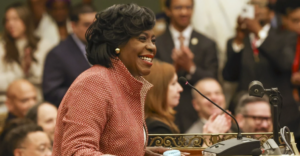Women’s Share of Council Seats in Big Cities Has Grown Dramatically
Originally published by Katie Martin and Alix Sullivan for Governing
The makeup of city councils nationwide tends to change every four years because of resignations, the election of new members and term limits, among other reasons. A review of 15 large-city councils by The Pew Charitable Trusts highlights some major changes in 2024, particularly in the share of seats held by women.
The analysis provides a snapshot of the city councils in Baltimore; Boston; Chicago; Dallas; Detroit; Houston; Los Angeles; New York City; Philadelphia; Phoenix; Pittsburgh; San Antonio; San Diego; San Jose, Calif.; and Washington, D.C. Although these cities may not all be on the same election cycle, they provide a view of city councils in large cities throughout the country.
One of the most significant changes since 2016, when Pew last conducted a similar analysis, is the increased share of women serving on city councils. All but two of the comparison cities — San Diego and Washington — boosted the number of women on their legislative bodies during this period. And as of 2024, six cities have majority female representation; none did in 2016.
Phoenix has the highest percentage of female representation at 78 percent, while Baltimore has the lowest at 27 percent. There were no publicly identified nonbinary members serving on these councils.
Among the 15 city councils examined, the overall share of female representation on the local legislatures increased from 31 percent in 2016 to 47 percent in 2024.
